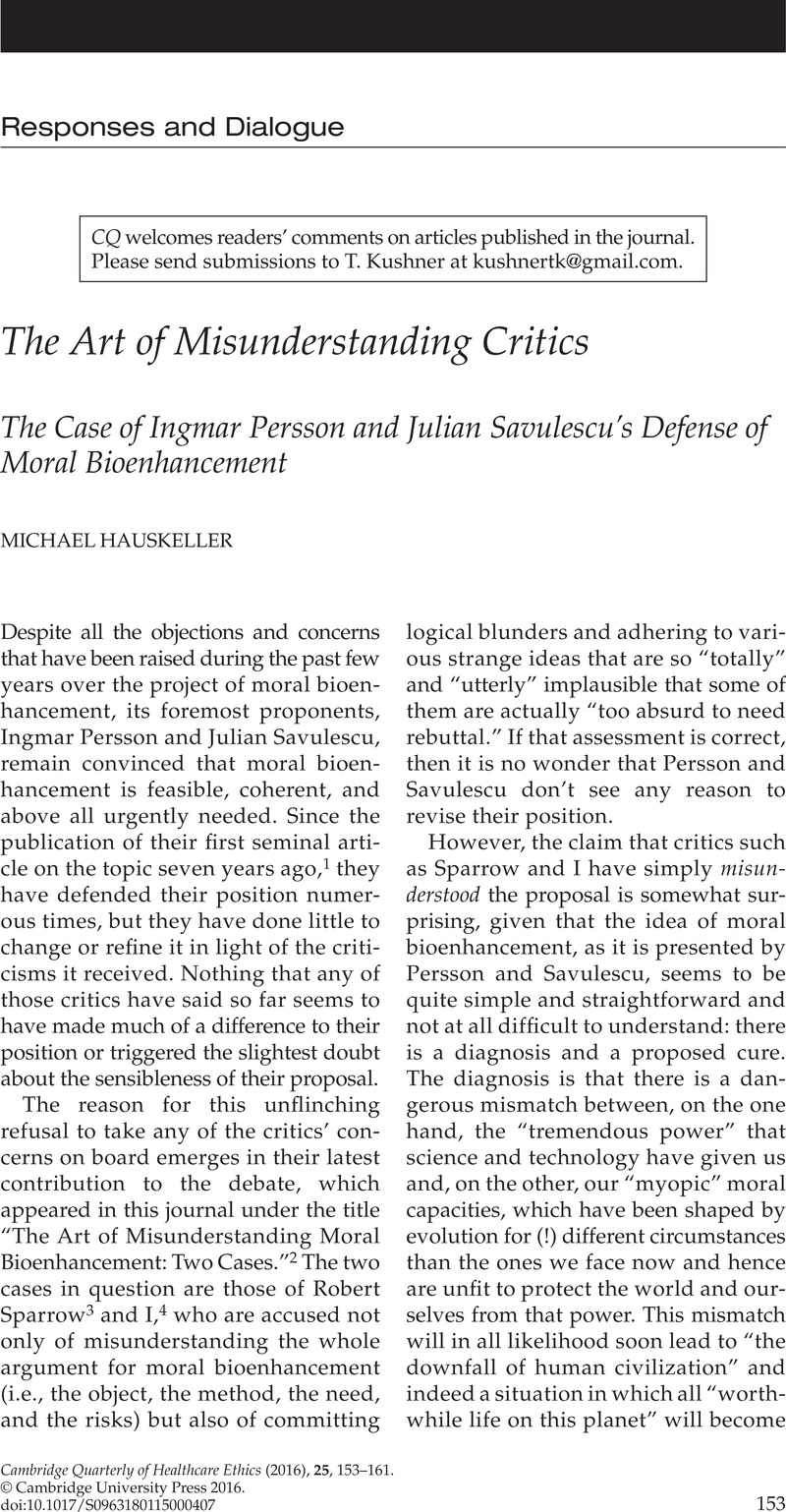Article contents
The Art of Misunderstanding Critics
The Case of Ingmar Persson and Julian Savulescu’s Defense of Moral Bioenhancement
Published online by Cambridge University Press: 20 January 2016
Abstract

- Type
- Departments and Columns
- Information
- Copyright
- Copyright © Cambridge University Press 2016
References
Notes
1. Persson, I, Savulescu, J. The perils of cognitive enhancement and the urgent imperative to enhance the moral character of humanity. Journal of Applied Philosophy 2008;25:162–76.CrossRefGoogle Scholar
2. Persson, I, Savulescu, J. The art of misunderstanding moral bioenhancement: Two cases. Cambridge Quarterly of Healthcare Ethics 2015;24(1):48–57.CrossRefGoogle Scholar
3. Sparrow, R. Better living through chemistry? A reply to Savulescu and Persson on “moral enhancement.” Journal of Applied Philosophy 2014;31:23–32.CrossRefGoogle Scholar
4. Hauskeller, M. Better Humans? Understanding the Enhancement Project. Durham, UK: Acumen; 2013.Google Scholar
5. For a more systematic treatment of these and other unexamined assumptions, see de Melo-Martin, I, Salles, A. Moral bioenhancement: Much ado about nothing? Bioethics 2014;29(4): 223–32.CrossRefGoogle ScholarPubMed
6. Vojin Rakic (Rakic, V. Voluntary moral enhancement and the survival-at-any-cost bias. Journal of Medical Ethics 2014;40:246–50CrossRefGoogle ScholarPubMed) has recently argued for voluntary moral enhancement in order to preserve human freedom, which he thinks should under no circumstances be sacrificed. I agree with the sentiment, but it is very unlikely that we will all voluntarily subject ourselves to a novel procedure designed to make us pursue a certain course of action that we are not really willing to pursue now. And it will certainly not reach the bad guys that threaten us with ultimate harm. For Persson and Savulescu’s proposal to work, moral bioenhancement has to be made compulsory and enforceable. This point was forcefully made by Timothy Murphy: Murphy, TF. Preventing ultimate harm as the justification for biomoral modification. Bioethics 2014;29(5): 369–77.CrossRefGoogle ScholarPubMed
7. This point was also recently emphasized by Birgit Beck: Beck, B. Conceptual and practical problems of moral enhancement. Bioethics 2014;29(4): 233–40.CrossRefGoogle ScholarPubMed
8. Crocket, MJ, Clark, L, Hauser, MD, Robbins, TW. Serotonin selectively influences moral judgment and behaviour through effects on harm aversion. Proceedings of the National Academy of Sciences of the United States of America 2010;107(40):17433–8.CrossRefGoogle Scholar
9. See note 8, Crocket et al. 2010, at 17437.
10. Harris, J. Moral enhancement and freedom. Bioethics 2011;25(2):102–11.CrossRefGoogle ScholarPubMed
11. Persson, I, Savulescu, J. Moral enhancement, freedom and the God machine. The Monist 2012;95(3):399–421.Google Scholar
12. See note 4, Hauskeller 2013, at 52.
13. James, W. The moral philosopher and the moral life. In: James, W. Pragmatism and Other Writings. London: Penguin; 2000, at 255–6.Google Scholar
- 9
- Cited by




